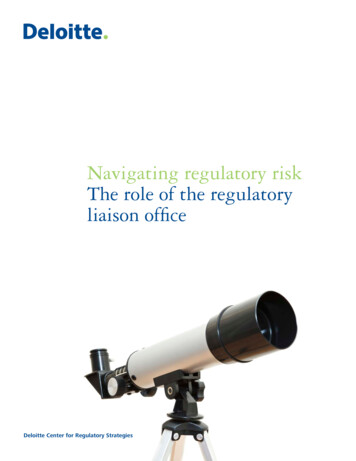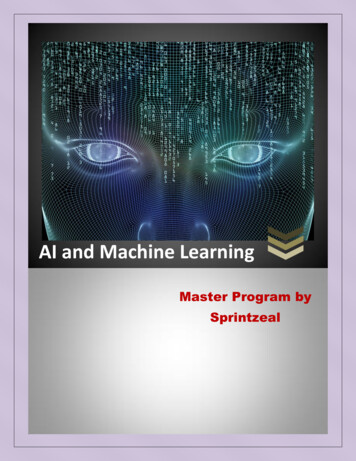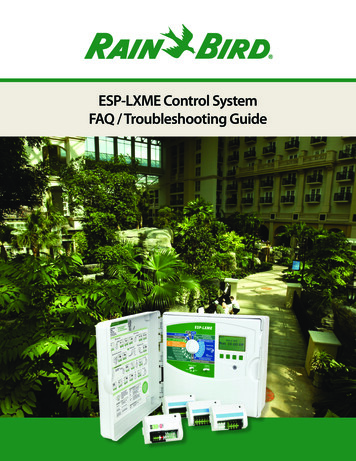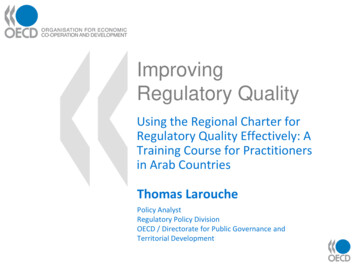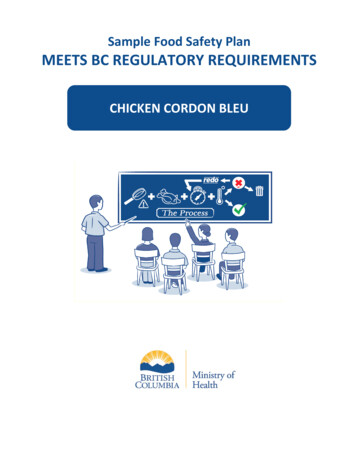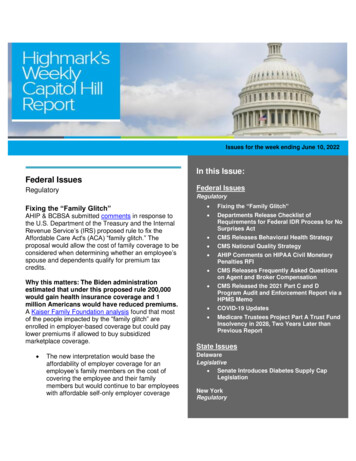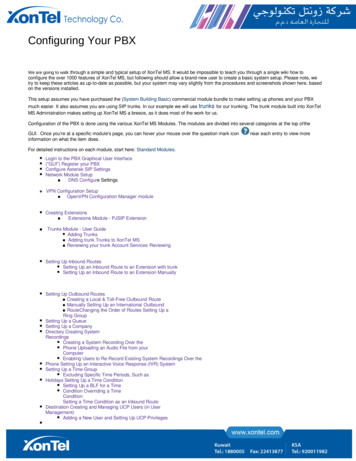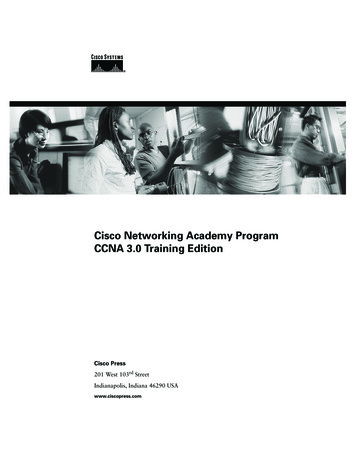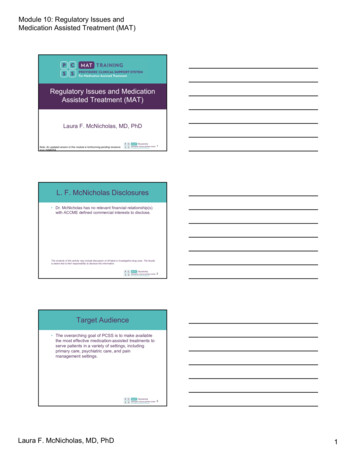
Transcription
Module 10: Regulatory Issues andMedication Assisted Treatment (MAT)Regulatory Issues and MedicationAssisted Treatment (MAT)Laura F. McNicholas, MD, PhDNote: An updated version of this module is forthcoming pending revisionsfrom SAMHSA.1L. F. McNicholas Disclosures Dr. McNicholas has no relevant financial relationship(s)with ACCME defined commercial interests to disclose.The contents of this activity may include discussion of off label or investigative drug uses. The facultyis aware that is their responsibility to disclose this information.2Target Audience The overarching goal of PCSS is to make availablethe most effective medication-assisted treatments toserve patients in a variety of settings, includingprimary care, psychiatric care, and painmanagement settings.3Laura F. McNicholas, MD, PhD1
Module 10: Regulatory Issues andMedication Assisted Treatment (MAT)Educational Objectives At the conclusion of this activity participants should beable to: Describe the legal differences between an opioidtreatment program (OTP) and office-based practice Demonstrate if, and when, the prescriber canincrease the number of patients to be treated withbuprenorphine products List which medical professionals may prescribe ordispense buprenorphine products, and under whichconditions they may prescribe or dispense Explain the needed confidentiality of patient recordsfor patients in substance use treatment Demonstrate how to appropriately practice usingtelemedicine4Outline 42 Code of Federal Regulations (CFR), Part 8 –OTP Regulations Drug Addiction Treatment Act of 2000 (DATA 2000) Comprehensive Addiction and Recovery Act(CARA) 42 CFR, Part 2 – Confidentiality5Controlled Substances Act Controlled Substances Act of 1972 is theoverarching legislation covering theappropriate prescribing and dispensing ofcontrolled substances It is this legislation that mandates thatmethadone is only to be used in OTPs, andprior to 2000, it forbid doctors from prescribingopioids to patients suspected or known to have asubstance use disorder DATA 2000, and later CARA 2016, amended thislegislation6Laura F. McNicholas, MD, PhD2
Module 10: Regulatory Issues andMedication Assisted Treatment (MAT)Treating Opioid Use Disorder (OUD)with MAT and the Law Buprenorphine in Office-Based Practice – DATA 2000and amendments, CARA Naltrexone – no legal restrictions Methadone in OTP – 42 CFR, Part 8 Buprenorphine in OTP – 42 CFR, Part 87Drug Addiction Treatment Act of 2000(DATA 2000) An amendment to the ControlledSubstances Act Allows practitioner to prescribe FDAapproved narcotic drugs in schedule III,IV, V, or combinations of such drugs,for maintenance or detoxificationtreatment8DATA 2000 Permits no limitations on the quantities of the drugsthat may be provided for unsupervised use, unlessthe drugs have been subject to adversedetermination Drugs and practitioner must meet certainrequirements9Laura F. McNicholas, MD, PhD3
Module 10: Regulatory Issues andMedication Assisted Treatment (MAT)DATA 2000 Practitioner Requirements: “Qualifying physician” Has capacity to refer patients forappropriate counseling and ancillaryservices No more than 30 patients (individualpractice) for the first year May request approval to treat up to 100 patients after thefirst year10DATA 2000 “Qualifying Physician” Board certified in Addiction PsychiatryCertified in Addiction Medicine by the American Board of AddictionMedicine (ABAM)Certified in Addiction Medicine by the American OsteopathicAcademy (AOA)Investigator in buprenorphine clinical trials leading to FDA approvalHas completed 8 hours of training provided by one of the followingorganizations (or others designated by HHS): American Academy of Addiction Psychiatry (AAAP) American Medical Association (AMA) American Osteopathic Academy of Addiction Medicine (AOAAM) American Psychiatric Association (APA) American Society of Addiction Medicine (ASAM)Training/experience as determined by state medical licensing boardOther criteria established by the Secretary of HHS11DATA 2000 Must notify the Secretary of HHS online: His/Her name DEA registration Category for qualification (1 to 7) as noted in previous slide Certify intention to comply with lawNotifications must be submitted online actitioner-type.php12Laura F. McNicholas, MD, PhD4
Module 10: Regulatory Issues andMedication Assisted Treatment (MAT)DATA 2000 Narcotic Drug:(Narcotic is used here in the legal sense of the ControlledSubstances Act: It includes all opioid products as well as other drugsand medications such as cocaine and illegal substances) Approved by the FDA for use in maintenance ordetoxification treatment of opioid use disorder Schedule III, IV, or V Drugs or combinations of drugs Buprenorphine is the only drug currently approved(Schedule III)13Buprenorphine Formulations - DATA200014Not Approved – DATA 2000 MethadoneBuprenorphine immediate release injectable (Buprenex )Sublingual film for pain (Belbuca )Transdermal buprenorphine (Butrans )TramadolAny medication not on the approved list DATA 2000 and CARA only apply to scheduled medications.15Laura F. McNicholas, MD, PhD5
Module 10: Regulatory Issues andMedication Assisted Treatment (MAT)DATA 2000 and Hospitalized Patient Use of buprenorphine productsin hospital setting: If a patient is in the hospital for reasonsother than substance use disorder,buprenorphine may be ordered by anyprovider for medical stabilization for theduration of hospitalization. If the patient is not to continue with opioid use disorder (OUD)treatment, the patient should be tapered off buprenorphineappropriately before discharge. If the patient is to be continued on OUD treatment afterdischarge, arrangements for that treatment with an OTP orDATA-waived practitioner MUST be done prior to discharge.16DATA 2000 Use of buprenorphine products in medicalemergencies for the treatment of OUD: If a patient is seen for emergency care and wantstreatment for OUD, but no OTP or DATA-waivedpractitioner is available, the emergencypractitioner may invoke the “72 Hour Rule” or“3-Day Rule.”1772 Hour Rule or 3-Day Rule “3-Day Rule” According to the DEA, an exception to the registrationrequirement, known as the “three-day rule” (Title 21, Codeof Federal Regulations, Part 1306.07(b)), allows apractitioner, who is not separately registered as a narcotictreatment program or certified as a DATA-waiveredpractitioner, to administer (but not prescribe) narcoticdrugs to a patient for the purpose of relieving acutewithdrawal symptoms while arranging for the patient’sreferral for treatment, under the following conditions: Not more than one day’s medication may beadministered or given to a patient at one time Treatment may not be carried out for more than 72hours The 72-hour period cannot be renewed or extended18Laura F. McNicholas, MD, PhD6
Module 10: Regulatory Issues andMedication Assisted Treatment (MAT)CARA 2016 Revised Regulations: Physicians may request approval to treat up to275 patients after one year at 100 patients (asallowed under DATA 2000) These physicians must be board certified inaddiction psychiatry or addiction medicine orpractice in a qualified practice setting Annual reporting requirements Legislation: Signed into law 7/22/201619CARA 2016 Expands prescribing privileges to nursepractitioners (NPs) and physicianassistants (PAs) for five years(until October 1, 2021) NPs and PAs must complete 24 hours oftraining to be eligible for a waiver to prescribe andmust be supervised by or work in collaboration witha qualifying physician if required by state law20CARA 2016 Qualified Practice Setting: Provides 24 hour emergency coverage Provides case management and related services Use health information technology Registered with state prescription monitoringprogram Accepts third-party payment for some services21Laura F. McNicholas, MD, PhD7
Module 10: Regulatory Issues andMedication Assisted Treatment (MAT)CARA 2016 New Standards of Care: Board certified practitioners Access to behavioral healthservices Follows evidence-basedtreatment guidelines Individualized treatment plans Diversion control plans Use of state Prescription Drug MonitoringProgram Annual reporting requirements22CARA Reporting Requirements Average monthly caseload of patients receivingbuprenorphine based MAT, per year Percentage of active buprenorphine patients thatreceived psychosocial services (either by directprovision, including medical management or referral)in the past year due to: Treatment initiation Change in clinic status Percentage of patients who had a Prescription DrugMonitoring Program (PDMP) query in the past month23CARA Reporting Requirements(cont) Number of patients at the end of the reporting year who: Have completed an appropriate course of treatmentwith buprenorphine for the patient to achieve andsustain recovery Are not being seen by the provider due to referral tomore OR less intensive level of care No longer desires to continue use of buprenorphine Are no longer receiving buprenorphine for otherreasons24Laura F. McNicholas, MD, PhD8
Module 10: Regulatory Issues andMedication Assisted Treatment (MAT)42 CFR, Part 8 Treatment governed by Federal Regulation 42 CFR Part 8 Accreditation and certification based system of OTPs Oversight – Substance Abuse and Mental HealthServices Administration (SAMHSA)/Center forSubstance Abuse Treatment (CSAT)/Division ofPharmacologic Therapies (DPT) Oversight to improve treatment not just regulate Tripartite oversight Department of Health and Human Services(DHHS)/SAMHSA (certification) State (licensure / registration) Drug Enforcement Agency (DEA) (registration)2542 CFR, Part 8 Initial application/provisional certification for 1 year Recertification at least every 3 years Requires compliance with state statues andregulations Apply to SAMHSA for:– Addition of new medical units– Relocation Notify SAMSHA of program changes– Program Sponsor– Medical Director } Within 3 weeks2642 CFR, Part 8.12 Administrative and organizational structureQuality assurance/improvementDiversion control planStaff credentialsPatient admission criteriaRequired servicesRecord keeping and patient confidentialityMedication dispensing and administrationUnsupervised use (take-home doses)Interim maintenanceDetoxification27Laura F. McNicholas, MD, PhD9
Module 10: Regulatory Issues andMedication Assisted Treatment (MAT)42 CFR, Part 8 - Definitions “Short-term detoxification” is define as 30 days “Long-term detoxification” is define as 30 – 180 days “Maintenance” treatment is define as: “Comprehensive” treatment Medical “rehabilitative”services “Interim” treatment is define as: Medical services while awaitingreferral to “comprehensive” treatment Maximum of 120 days, must refer tocomprehensive treatment thereafter2842 CFR, Part 8 – AdmissionCriteria Qualified personnel using accepted medical criteria,Diagnostic Statistical Manual (DSM) diagnoses thepatient with an opioid use disorder including: Current physiological dependence Has been dependent at least 1 year prior toadmission AND the patient: Voluntarily chooses maintenance treatment Has relevant facts concerning use of opioids clearlyand adequately explained Has provided written informed consent to treatment,(standard example form) in Appendix of CSATAccreditation Guidelines of OTPs2942 CFR – Part 8 Patient less than 18 years old Two documented unsuccessfulattempts at short-term detoxification ordrug-free treatment within a (12) monthperiod Parent or legal guardian consents in writing30Laura F. McNicholas, MD, PhD10
Module 10: Regulatory Issues andMedication Assisted Treatment (MAT)Buprenorphine in OTP Patients may chose buprenorphine/naloxone in an OTP that offers bothmethadone and buprenorphine/naloxone. The clinic is not restricted in thenumber of patients receiving buprenorphine, as areoffice-based under DATA 2000. The federal guidelines for methadone take-homedoses are not applicable to patients receivingbuprenorphine/naloxone, but the labeling must meetOTP and local standards.31Confidentiality The law, 42 CFR Part 2, and regulations werewritten during a time of great concern about thepotential use of substance use disorder informationagainst an individual. The purpose of 42 CFR Part 2 is to ensure that apatient receiving treatment for a substance usedisorder in a Part 2 program is not made morevulnerable than an individual with a substance usedisorder who does not seek treatment.32Confidentiality The scope of the law Restricts disclosure and use of patient-identifyinginformation, including reporting to PDMPs Patient-identifying information is anything thatreveals a person is receiving, has received, orhas applied for substance use disorder treatment. Cannot disclose participation in substance usedisorder treatment – but can disclose identityunder some circumstances Includes current, former, and deceased patients33Laura F. McNicholas, MD, PhD11
Module 10: Regulatory Issues andMedication Assisted Treatment (MAT)Confidentiality Background on 42 CFR Part 2 applies tofederally assisted “alcohol and drugabuse” programs. Patient consent must be obtained beforesharing information from a program that issubject to 42 CFR Part 2. Once this information has been disclosed,no re-disclosure is permitted without thepatient’s express consent to re-disclose orunless otherwise permitted under Part 2.34Confidentiality A program is considered to be federally assisted if:1. It is conducted in whole or in part, whether directly or bycontract or otherwise by any department or agency ofthe United States (but forget this if VA or DoD);1. It is being carried out under a license, certification,registration, or other authorization granted by anydepartment or agency of the United States including butnot limited to: (i) Participating provider in the Medicare program; (ii) Authorization to conduct maintenance treatmentor withdrawal management; or (iii) Registration to dispense a substance under theControlled Substances Act to the extent thecontrolled substance is used in the treatment ofsubstance use disorders.35Confidentiality Currently, the definition does not apply to generalmedical facilities, but does apply to generalmedical/psychiatric practices. Added definition: “Treating provider relationship meansthat, regardless of whether there has been an actual in-personencounter, (a) a patient agrees to be diagnosed, evaluatedand/or treated for any condition by an individual or entity and(b) the individual or entity agrees to undertake diagnosis,evaluation and/or treatment of the patient, or consultation withthe patient, for any condition.”36Laura F. McNicholas, MD, PhD12
Module 10: Regulatory Issues andMedication Assisted Treatment (MAT)Confidentiality Limited exceptions for disclosure without consent: Medical emergencies Scientific research Audits and evaluations Medicare, Medicaid, CHiP Child abuse reporting Crimes on program premises or against programpersonnel Court order (NOT subpoena) Communications with a qualified service organization(QSO) of information needed by the organization toprovide services to the program37Confidentiality Breach of privacy of information protected by Part 2can still lead to civil and criminal consequences forpatients. Loss of employment, housing, child custody Discrimination by medical professionals andinsurers Arrest, prosecution and incarceration Modernize the regulations and make them moreunderstandable and less burdensome.38Definition of Telemedicine The term "practice oftelemedicine" means, forpurposes of this subchapter,the practice of medicine inaccordance with applicableFederal and State laws by apractitioner (other than apharmacist) who is at a location remote from thepatient and is communicating with the patient, orhealth care professional who is treating the patient,using a telecommunications system referred to insection 1395m(m) of title 42, which cfr/21usc/802.htm.Laura F. McNicholas, MD, PhD13
Module 10: Regulatory Issues andMedication Assisted Treatment (MAT)Definition of Telemedicine (A) is being conducted— (i) while the patient is being treated by, andphysically located in, a hospital or clinicregistered under section 823(f) of this title; and (ii) by a practitioner— (I) acting in the usual course of professionalpractice; (II) acting in accordance with applicable Statelaw; and (III) registered under section 823(f) of this titlein the State in which the patient is located40Telemedicine DEA’s statement “Use of Telemedicine whileproviding MAT” emphasizes that all conditions of thedefinition of telemedicine must be met, therefore The physician providing telemedicine must belicensed in the state in which the patient is seen. Must have all appropriate state licenses,including, if needed a state DEA license. Should have a practice agreement with the clinicor practice in which the patient is seen.41Telemedicine If all the above are met, then thephysician does not have to do theinitial or follow-up interviewsface-to-face. The physician should ensurethat the person doing theevaluation is qualified to adequatelyassess the patient and to determineif the patient needs and qualifies forprescribed buprenorphine.42Laura F. McNicholas, MD, PhD14
Module 10: Regulatory Issues andMedication Assisted Treatment (MAT)Summary 42 CFR, Part 8, governing OTPs, primarily methadone,is very rigid and restrictive. DATA 2000 and CARA 2016 allow for the prescribing ofSchedule III, IV and V medications for the treatment ofOUD; the medications used under these laws andregulations must be FDA-approved for treating OUD. Confidentiality of patients and their records in substanceuse treatment is more stringent than normal andgoverned under 42 CFR, Part 2, revised in 2017 (morerevision is probable). Telemedicine is allowed under the Ryan WhiteExemption.43References SAMHSA MAT info www.samhsa.gov/medication-assisted-treatment Federal Guidelines for Opioid Treatment Programs(January 2015) P15-FEDGUIDEOTP.pdf 42 CFR, Part 2 egulations-guidelines44References DATA 2000 edtreatment/legislation-regulations-guidelines CARA 2016 ppa-waivers Laura F. McNicholas, MD, PhD15
Module 10: Regulatory Issues andMedication Assisted Treatment (MAT)PCSS Mentor Program PCSS Mentor Program is designed to offer general information to cliniciansabout evidence-based clinical practices in prescribing medications for opioidaddiction. PCSS mentors are a national network of providers with expertise inaddictions, pain, evidence-based treatment including medicationassisted treatment. 3-tiered approach allows every mentor/mentee relationship to be unique andcatered to the specific needs of the mentee. No cost.For more information visit:pcssNOW.org/mentoring46PCSS Discussion ForumHave a clinical question?47PCSS-MAT is a collaborative effort led by the American Academy of Addiction Psychiatry (AAAP) inpartnership with the: Addiction Technology Transfer Center (ATTC); American Academy of FamilyPhysicians (AAFP); American Academy of Neurology (AAN); American Academy of Pain Medicine (AAPM);American Academy of Pediatrics (AAP); American College of Emergency Physicians (ACEP); AmericanCollege of Physicians (ACP); American Dental Association (ADA); American Medical Association (AMA);American Osteopathic Academy of Addiction Medicine (AOAAM); American Psychiatric Association (APA);American Psychiatric Nurses Association (APNA); American Society of Addiction Medicine (ASAM);American Society for Pain Management Nursing (ASPMN); Association for Medical Education andResearch in Substance Abuse (AMERSA); International Nurses Society on Addictions (IntNSA); NationalAssociation of Community Health Centers (NACHC); National Association of Drug Court Professionals(NADCP), and the Southeast Consortium for Substance Abuse Training (SECSAT).For more information: rojects/Funding for this initiative was made possible (in part) by grant nos. 5U79TI026556-02 and 3U79TI026556-02S1 from SAMHSA. Theviews expressed in written conference materials or publications and by speakers and moderators do not necessarily reflect theofficial policies of the Department of Health and Human Services; nor does mention of trade names, commercial practices, ororganizations imply endorsement by the U.S. Government.Laura F. McNicholas, MD, PhD16
Board certified in Addiction Psychiatry Certified in Addiction Medicine by the American Board of Addiction Medicine (ABAM) Certified in Addiction Medicine by the American Osteopathic Academy (AOA) Investigator in buprenorphine clinical trials leading to FDA approval Has completed 8 hours of training provided by one of the following


